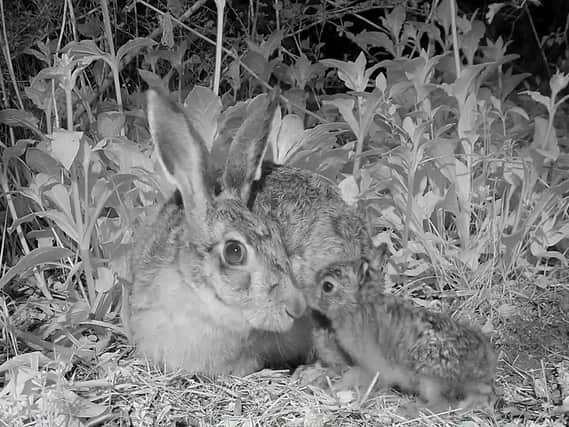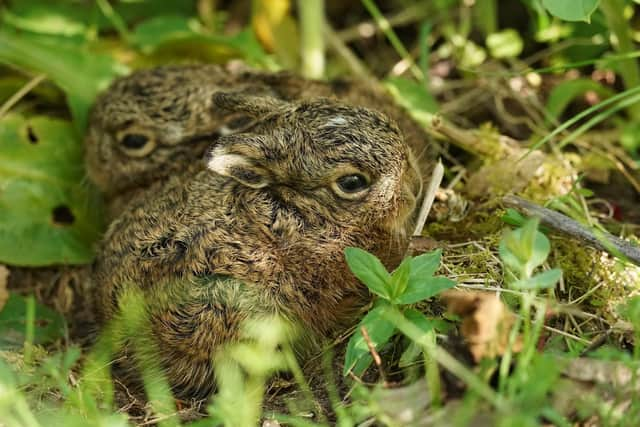Wildlife artist Robert Fuller captures the elusive sight of a hare raising her leverets in the woodland outside his home


I looked up just in time to see a hare lollop away.
I peered into the spot it had just vacated and there in a flowering clump of pink campion were two new-born hares.
Known as leverets, these were some of the youngest I had ever seen. At less than four inches long they had to be only a day or so old.


Advertisement
Hide AdAdvertisement
Hide AdThey crept around on unsteady feet in a small hollow in the wild flower patch. This was clearly their forme, scraped out for them by their mother when she gave birth.
Female hares only feed their leverets briefly at dusk or after dark and I’ve always wanted to study this secretive behaviour.
Now here was a hare forme just 50 metres from my studio and in reach of my network of hidden cameras.
I set about training my cameras, including some infrared equipment, onto this forme so that I could study the action day and night from TV monitors in my studio.
Advertisement
Hide AdAdvertisement
Hide AdThat evening I settled down to my first evening of leveret watching. But the hare didn’t turn up. I was worried, since the leverets were so young, but as the cameras flipped over to infrared on the second night, the leverets emerged, sniffing the ground.
Suddenly they crouched down side by side and at that precise moment a hare arrived in the car park. I followed it on my screens as it moved through the front gates, across the car park, behind the workshop and towards the woodland where the leverets waited.
She moved cautiously, stopping frequently to sniff the air, and it was 10 minutes before I saw the leveret’s ears flatten on the screen.
Then a second later her shadow loomed over them followed by her head, held low as she sniffed each leveret and licked their heads in turn.
Advertisement
Hide AdAdvertisement
Hide AdSeeing the leverets next to her gave a sense of scale. The two crouched together were the same size as her head. Once the greetings were over, the female braced her front legs and allowed them to crawl underneath to feed.
I watched as she fussed over them, licking them all over. All the while she listened out for danger, lifting her head to twitch her nose and flick her ears.
As the leverets fed she turned them over one by one and licked their rear ends. It is common for mammals to eat the droppings of their young. Not only does this help them regain nutrients, but it also minimises their scent, protecting them from predators.
After about 10 minutes, the leverets were feeding only half-heartedly and the female began to paw gently at the ground and pull leaves over them. It had been such a brief visit.
Advertisement
Hide AdAdvertisement
Hide AdAs I watched her slowly hop out of the forme and across the gallery car park, I wasn’t the only one following her movements. Up above a tawny owl shadowed her as she made off into the fields. It’s quite common for owls to follow hares in the hope they will lead them to their leverets. Although this hare’s time with her young seemed brief, she had their best interests at heart.
The following evening the leverets waited for their mother just off camera. I watched the female arrive, loping first through the car park just as she had the day before.
When she got to the leverets she walked them back into the forme before turning to greet them. They pawed at her trying to push their way under her and she lifted one front paw and braced her front legs wide apart to let them suckle. Again, just as she was about to leave, she tucked them under some leaves. This time her visit lasted just seven minutes and as she left I spotted a stoat on the camera just two metres away from the leverets.
The following morning, I put up more cameras and a microphone. I had read that hares call up their young to be fed and I found this hard to believe.
Advertisement
Hide AdAdvertisement
Hide AdI have only ever heard a hare make a noise when in distress. The moment a female feeds her leverets is so secretive it made no sense that she would draw attention to it by calling out.
As dusk fell on the next night, I watched from nine separate monitors in my office and studio, listening for any sound from a speaker connected to a microphone on one of the cameras.
I heard the female hare’s footsteps before she came into shot. The microphone was so sensitive I could hear the thud of every hop. She did not call, but instead sniffed the ground. The leverets also sniffed at the ground before they settled to wait for her.
I concluded that a hare locates her leverets by scent. She possibly also leaves a scent to let her young know where to wait.
Advertisement
Hide AdAdvertisement
Hide AdThe leverets grew fast and soon split up and hid separately during the day. This tactic mitigates any risk of an entire litter being lost in one go.
But every evening both leverets would return to the same spot to wait for the female.
Then one evening there was only one leveret waiting. The female arrived and allowed it to suckle as usual. Then she checked all the places she had fed the pair over the course of the week.
Usually her visits were short, but this time she hung around for 50 minutes looking for her other leveret. The next morning, she was back at 5am, but sadly only one leveret was there. She let it feed. This was the first time I had seen her feed her leveret more than once a day. When she left I noticed a weasel crossing the path close to the forme.
Advertisement
Hide AdAdvertisement
Hide AdBy the following day, it was clear that she had lost one leveret. I too began checking through all my cameras and the next morning even headed out to see if I could find it.
I didn’t but I did spot its sibling at the base of a small tree, its body curved round the trunk. A single dandelion flower hung over it – as if marking this hiding place.
It lay still, its ears back. Only the gentle rise of its back as it breathed told me it was alive. Otherwise it was so well camouflaged it looked as though it was a part of the tree.
One morning a sudden movement on the camera caught my eye as the female hare rushed into shot. She crouched down near the forme, her ears back. Then a male hare charged onto the scene. They paused momentarily then she was off, with him in hot pursuit.
Advertisement
Hide AdAdvertisement
Hide AdI followed them on the screens as they ran across the car park, over the fields and disappeared over the horizon like characters in a cartoon.
Hares can have four litters a year and clearly the life cycle was about to start again.